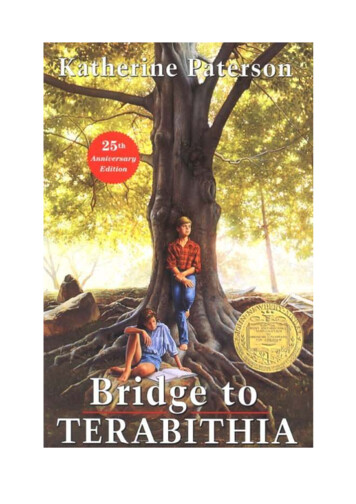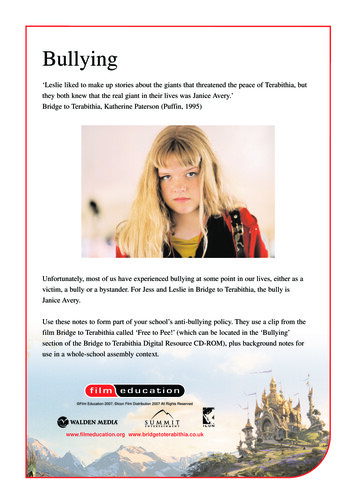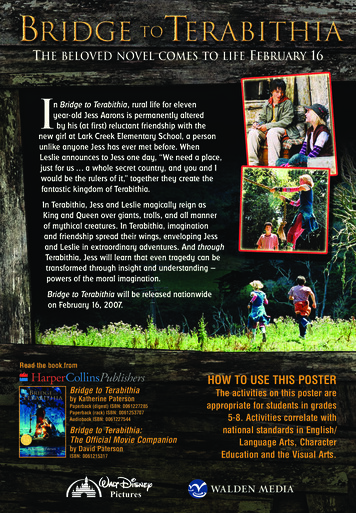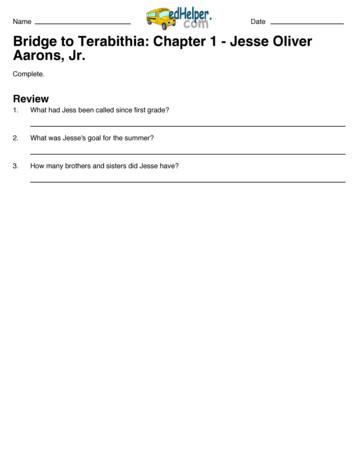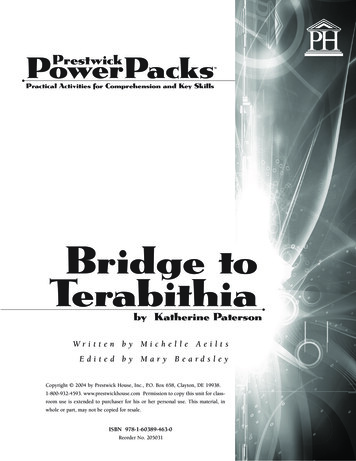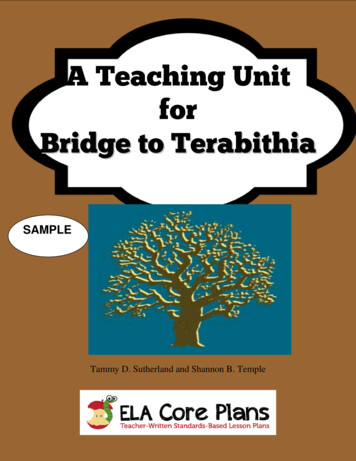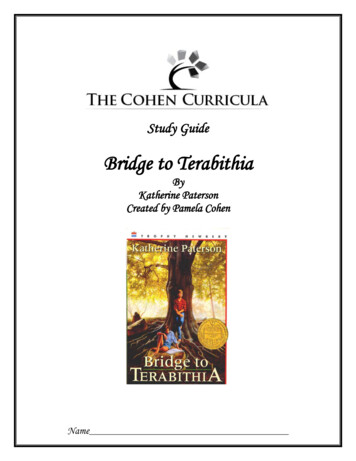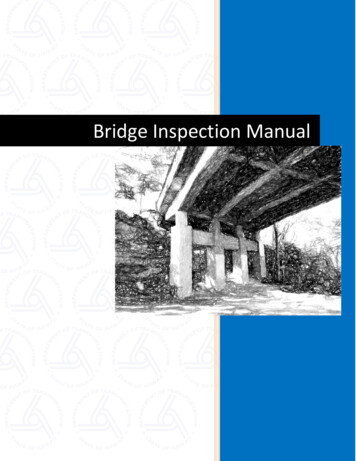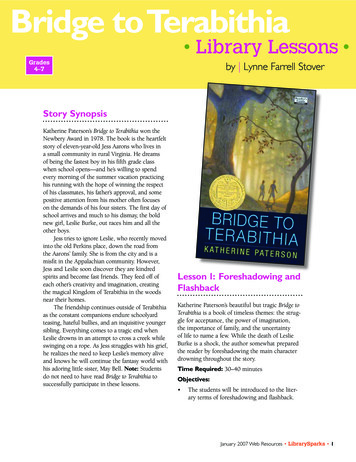
Transcription
Bridge to Terabithia Library Lessons Grades4–7by Lynne Farrell StoverStory SynopsisKatherine Paterson’s Bridge to Terabithia won theNewbery Award in 1978. The book is the heartfeltstory of eleven-year-old Jess Aarons who lives ina small community in rural Virginia. He dreamsof being the fastest boy in his fifth grade classwhen school opens—and he’s willing to spendevery morning of the summer vacation practicinghis running with the hope of winning the respectof his classmates, his father’s approval, and somepositive attention from his mother often focuseson the demands of his four sisters. The first day ofschool arrives and much to his dismay, the boldnew girl, Leslie Burke, out races him and all theother boys.Jess tries to ignore Leslie, who recently movedinto the old Perkins place, down the road fromthe Aarons’ family. She is from the city and is amisfit in the Appalachian community. However,Jess and Leslie soon discover they are kindredspirits and become fast friends. They feed off ofeach other’s creativity and imagination, creatingthe magical Kingdom of Terabithia in the woodsnear their homes.The friendship continues outside of Terabithiaas the constant companions endure schoolyardteasing, hateful bullies, and an inquisitive youngersibling. Everything comes to a tragic end whenLeslie drowns in an attempt to cross a creek whileswinging on a rope. As Jess struggles with his grief,he realizes the need to keep Leslie’s memory aliveand knows he will continue the fantasy world withhis adoring little sister, May Bell. Note: Studentsdo not need to have read Bridge to Terabithia tosuccessfully participate in these lessons.Picture?Lesson 1: Foreshadowing andFlashbackKatherine Paterson’s beautiful but tragic Bridge toTerabithia is a book of timeless themes: the struggle for acceptance, the power of imagination,the importance of family, and the uncertaintyof life to name a few. While the death of LeslieBurke is a shock, the author somewhat preparedthe reader by foreshadowing the main characterdrowning throughout the story.Time Required: 30–40 minutesObjectives: The students will be introduced to the literary terms of foreshadowing and flashback.January 2007 Web Resources LibrarySparks 1
Library Lessons The students will be involved in an interactive activity that will reinforce the conceptsintroduced.Materials: Foreshadowing and Flashback: Triumphs &Troubles in Terabithia visual (page 4) Triumphs & Troubles Tic-Tac-Toe visual(page 5) prepared activity cards (page 6) transparency markerDirections:1. Prior to the lesson, photocopy theForeshadowing and Flashback Game Cardsand have them cut and ready for class. (Keepa master copy of the cards to identify the correct answers.)2. Display the Foreshadowing visual. Read theinformation to the students.3. Ask the students if they can recall ever having read stories that used foreshadowing orflashback. (Flashback tends to be easier forthe students to identify. Foreshadowing canbe subtle and is not as identifiable.)4. Divide the students into two groups.5. Explain that the class is going to play a tictac-toe game using the information concerning foreshadowing and flashbacks.6. Display the Triumphs & Troubles Tic-Tac-Toevisual, read the directions, and go over therules with the class.7. Play the game, following the directions andusing the grid.8. Upon completion, congratulate the winning team and read any of the remainingForeshadowing and Flashback Game Cards tocheck for understanding.Extension: Encourage the students to createtheir own foreshadowing and flashback cardsbased on favorite books to be used in other classtic-tac-toe games.2 LibrarySparks January 2007 Web ResourcesLesson 2: Imaginary PlacesThe setting for Bridge to Terabithia is the raw andreal rural Virginia of the 1970s. Young Jess andLeslie find a way to temporarily “divorce” themselves from the reality of school situations andfamily stress when they fabricate their own private fantasy world created from books they haveread and their extremely active imaginations.Time Required: 20–30 minutesObjectives: The students will review the literary term“setting” and apply the definition to variousfictional works. The students will complete an assigned activity sheet.Materials: Imaginary Places visual (page 7) Imaginary Places activity sheet (page 8) writing tools titles of the featured books for student checkout (optional)Procedure:1. Prepare the visual and activity sheets priorto class.2. Introduce the lesson by explaining that thesetting of Bridge to Terabithia is in the “realworld,” but the title of the book is based onan imaginary place.3. Display the visual. Read it with the students.4. Solicit responses concerning informationabout the listed imaginary places from thestudents. Possible replies include:Bedrock—from the cartoon series TheFlintstones.Camelot—the location of King Arthur’sKnights of the Round Table.Dictionopolis & Digitopolis—the citiesvisited by Milo in Norton Juster’s ThePhantom Tollbooth.Krypton—Superman’s home planet.
Library LessonsThe Lost Island of Atlantis—legendary location of an advanced civilization that vanishedinto the ocean thousands of years ago.Olympus—mythical home of the Greek gods.Tatooine—home planet of the Star Warssaga’s young Luke Skywalker.Treasure Island—place of buried pirates’booty in a book of the same name by RobertLewis Stevenson.5. Pass out the activity sheet and read the introduction to the students. Note: The placeslisted are found in popular children’s literature. All book titles have been, (or soon willbe), made into movies and should be familiar to most students. However, this activityworks best if students are allowed to worktogether in pairs or small groups, as fewstudents are likely to have knowledge of allten books.6. Check as a group. Answers 1. J; 2. C; 3. F;4. I; 5. A; 6. H; 7. E; 8. B; 9. G; 10. D.McREL StandardsLanguage ArtsReading Uses the general skills and strategies of thereading process. Understands the use of specific literary devices (e.g., foreshadowing,flashback).Listening and Speaking Uses listening and speaking strategies fordifferent purposes. Lynne Farrell Stover has over thirty years ofexperience as an educator and is currently aTeacher Consultant at James Madison Universityin Harrisonburg, Virginia. She has taught manyteacher workshops and won Teacher of the Yearin 1999 from the Virginia Council of EconomicEducation and from the Virginia Association forthe Gifted. She is the author of Magical LibraryLessons, More Magical Library Lessons, and FromSnicket to Shakespeare from UpstartBooks.January 2007 LibrarySparks 3
Foreshadowing and FlashbackTriumphs & Troubles in TerabithiaForeshadowingWhen a writer foreshadows an event he or she uses clues or hints to tip off thereader that something has just occurred that is going to matter later. Foreshadowingis one of the ways a writer generates anticipation and prepares the reader for what iscoming next in the story.“There were parts of the woods that Jess did not like. Dark places where it was almostlike being underwater, but he did not say so.”This is an example of foreshadowing from Bridge toTerabithia by Katherine Paterson. The author is giving the reader clues that the woods was not alwaysa friendly place and that being underwater might bescary and dangerous.FlashbackA writer uses a flashback when he or she wantsthe reader to be aware of something that happenedbefore the beginning of the story. Flashbacks offerinformation about the characters’ current situationor make clear why certain things may be happeningin a story. When a flashback takes place, the chain ofevents in a story is interrupted.“But one day—April the twenty-second, a drizzlyMonday, it had been—he ran ahead of them all, thered mud slooching up through the holes in the bottom of his sneakers.”This is an example of a flashback from Bridge toTerabithia. Here the author takes the reader back intime to the event that gave Jess a “taste for winning.”4 LibrarySparks January 2007 Web Resources
Triumphs & Troubles in Terabithiax O x Tic-Tac-Toe x O x1.2.3.4.5.6.Divide the class into two groups.Decide which half will be the X group and which the O group.The group with the oldest student in it will go first.Draw a foreshadowing/flashback card from the deck and read it to the first group.The group must identify it correctly as an example of either foreshadowing or flashback.If they are correct, they may place an X or O on the grid. If they are incorrect, theylose their turn.7. Read a new card and give the second group an opportunity to identify it as an example ofeither foreshadowing or flashback.8. Repeat the pattern until one group succeeds in getting three X’s or O’s in a row.January 2007 Web Resources LibrarySparks 5
Foreshadowing and Flashback CardsForeshadowing CardsThe day was bright and beautifuland he had a feeling it was going themost exciting day of his life.Brenda couldn’t remember everbeing so hungry. She couldn’t waitto get home to eat dinner andwondered whose turn it wasto cook.Miss Edmunds was wearing a lightcotton dress and sandals.Soon she would want to have awarm jacket and some heavy socks.Singing this joyful song would be thelast happy thing May Belle would dofor a very long time.Three tragic events had happenedthis week. Things will surely changenow or so he thought.Mr. Burke placed the home repairbook back on the shelf. Later hewould wish he had read it fromcover to cover.Even though the forecast was forclear weather, heavy rain started tofall. She hoped the creek would notflood too much.Little did Jess know the newneighbor he just spied was going tomake such a difference in his life.Ellie asked, “What if you get lost?What if you can’t find your wayback? Are you sure you knowthe way?”He remembered the glorious daylast year when he had won his oneand only race.What had happened to Brendareminded her mother of a childhood event when she had been themost popular girl in school.When she went to bed that nighther dreams where of her former lifein the big city where He reminisced about the good timeswhen he and his best friend wouldplay for hours in the woods.Leslie may have been racing forward,but her memories were racing backwards to the last time she was inthis situation.That story brought to mind onehe had heard last year from hisfavorite teacher.The strong smell of maple syrupreminded Jess of that terriblemorning when What had just taken place inthe kitchen just now had startedthree months ago when his fatherasked him if he was still drawingsilly pictures.Janice was tired, hurt, and hungry,and she started to recollect the fewhappy times in her life.Flashback Cards6 LibrarySparks January 2007 Web Resources
lmaginary PlacesThe SETTING of a story is time and place of the action.In Bridge to Terabithia, the story’s characters live in the real world of rural Virginia in the 1970s.However, Jess and Leslie, the main characters, create the imaginary Kingdom of Terabithiawhere they can go to escape the care of school and family.The world is full of fantastic places that exist only in our imagination. Do you recognize anyof these fictional settings?BedrockCamelotDictionopolis & DigitopolisKryptonThe Lost Island of AtlantisOlympusTatooineTreasure IslandJanuary 2007 Web Resources LibrarySparks 7
lmaginary PlacesLeslie Burke, a main character in Katherine Paterson’s Bridge to Terabithia loves to read. In fact,the name she chooses for her secret place, the “Kingdom of Terabithia,” has a name similarto the island Terebinthia, found in Narnia, a fantasy world created by C. S. Lewis.Some authors create such interesting and imaginative settings, that these places become asfamiliar to the reader as the story’s characters.Can you match these imaginary places with the books in which they can be found?Places1. Hogsmeade, Hogwarts, Diagon Alley2. The Emerald City, Yellow Brick Road, Forest of the Winged Monkeys3. Neverland, Mermaid’s Lagoon, Skull Rock4. Rabbit Hole, March Hare’s House, Queen of Hearts’ Garden5. Rivendell, Hobbiton, Mirkwood6. Lilliput, Brobdingnag, Laputa7. Cornucopia, Temple Ruins, Volcaneum8. Cair Paravel, Narnia, Beaversdam9. Carvahall, Varden, The Spine10. Camazotz, Planet Ixchel, UrielBooks and AuthorsA.B.C.D.E.F.G.H.I.J.The Hobbit by J. R. R. TolkienThe Lion the Witch and the Wardrobe by C. S. LewisThe Wonderful Wizard of Oz by L. Frank BaumA Wrinkle in Time by Madeline L’EngleDinotopia: A Land Apart from Time by James GurneyPeter Pan by J. M. BarrieEragon by Christopher PaoliniGulliver’s Travels by Jonathan SwiftAlice in Wonderland by Lewis CarrollHarry Potter and the Sorcerers Stone by J. K. Rowling8 LibrarySparks January 2007 Web Resources
In Bridge to Terabithia, the story's characters live in the real world of rural Virginia in the 1970s. However, Jess and Leslie, the main characters, create the imaginary Kingdom of Terabithia where they can go to escape the care of school and family. The world is full of fantastic places that exist only in our imagination. Do you recognize any
